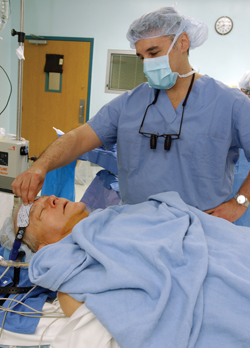
Jorge Balaguer, M.D., checks the brain oximetry patches on patient Robert Krause before his coronary bypass surgery. The patches evaluate the oxygen in the brain tissue before and during coronary bypass operations.
Photo by Dana Johnson
Brain monitoring easing stroke risk during surgery
In the past 16 months, none of the Veterans Administration Hospital's 150 cardiac surgery patients have experienced an intraoperative stroke, an impressive record considering these patients are typically at high risk for just such an adverse event.
The milestone is the result of a comprehensive approach that lowers neurological deficits by using a combination of techniques: cerebral oximetry that monitors the brain's balance of oxygen supply and demand; and epi-aortic ultrasound that locates atherosclerotic plaques in the ascending aorta which can break loose during cardiac operations and cause embolic strokes.
Jorge Balaguer, M.D., chief of Cardiac Surgery at the Nashville VA, introduced the twofold approach in 2005 when he joined Vanderbilt. The Monroe Carell Jr. Children's Hospital at Vanderbilt has also been utilizing the brain monitoring technique in its pediatric population, with similarly good results.
INVOS, a non-invasive cerebral oximeter, measures the changes in the balance of the oxygen supply and demand of the brain, which assists surgeons in preventing strokes and neurological complications caused by inadequate blood and oxygen supply.
“Before the INVOS, there really was no good way to monitor oxygen levels continuously,” Balaguer said. “These patients (veterans) are typically at high risk of stroke because they have severe peripheral vascular disease or cerebral vascular disease. So an absence of stroke in this patient population is remarkable.”
Balaguer came to Vanderbilt from the Brigham and Women's Hospital/Cape Cod Hospital satellite program and Harvard Medical School in Boston, where the neuro-protective strategy was developed.
The monitoring system has been used in a variety of medical settings, including cardiovascular surgery (both adult and pediatric), critical care and neonatal units as well as cardiac catheterization labs.
The system passes a low-intensity, near-infrared light through the patient's forehead and into the brain using patches called SomaSensors. The sensors are able to detect the absorption levels of blood oxygen. Two sensors are placed on the forehead of adult patients. Four-channel devices are currently under investigation.
In Balaguer's experience, another common cause of stroke, especially in the elderly, has been when atherosclerotic plaque that lines the aorta is loosened during a surgical procedure. Ruptured pieces of plaque can travel into the vessels that lead to the brain, blocking blood and/or oxygen. The lack of flow results in a stroke.
“The ultrasound gives us an image of where the plaque is located so we can place the necessary instruments in the ascending aorta for cardiac surgery, without disturbing the plaque,” he said.
“This is a part of our comprehensive strategy. We have had great clinical results with this combined strategy (brain oximetry and epi-aortic ultrasound).”
Brain oximetry is particularly important during cardiac surgery operations using the heart/lung machine, said Balaguer. While patients are hooked up to the heart/lung bypass machine during surgery, INVOS is a key monitoring system that provides a continuous check of the brain's blood oxygen balance.
This monitor allows surgeons, anesthesiologists and perfusionists to diagnose and correct any events which could lead to strokes or other neurologic injury.
“Frequently during cardiac surgery, a patient's oxygen levels decrease,” he said. “Desaturation is typically followed by more complications. INVOS serves as a surrogate for good flow and oxygen delivery to the brain.”
Prior to the introduction of INVOS it was impossible to prevent the decrease in brain oxygenation despite providing an adequate level of oxygen.
“Preventing strokes and other types of neurologic injury during cardiac surgery is a fundamental issue for our team,” he said. “It is well known that strokes are associated with increased mortality, morbidity, disability, hospital costs and high resource utilization in the hospital and in the post-hospital care settings.
“We are very encouraged with our great clinical results in preventing strokes using this combined approach. This neuro-protective strategy is currently used in all patients subjected to cardiac surgery operations at Vanderbilt as well as the VA.”













